“Moving House”
The Story behind the Painting
by Alvin Ong
The story of 3 affected graves at Bukit Brown not too long ago inspired a revival of family interest; Tan Yong Chuan (Blk 4, Div C), Tan Tiam Tee (Blk 3, Div B), Wee Geok Eng Neo (Blk 4, Div 6) were exhumed in May 2014. Old photos were unearthed from family albums, and heirloom objects from another era suddenly came to light. For the first time in decades, stories and narratives unlocked themselves from these objects and brought new layers of meaning to the notions of home and identity.
Tan Tiam Tee was the son of the magnate Tan Hoon Chiang (buried in Bukit China, Malacca), one of the founders of the Straits Steamship Co. His wife, Wee Geok Eng Neo, and his son, Tan Yong Chuan were all affected by the proposed highway.
(click on images for a bigger view)
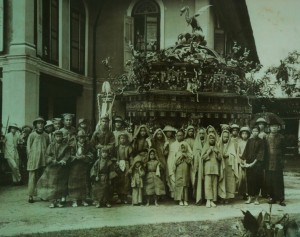
Funeral of Wee Geok Eng Neo, nee Mrs Tan Tiam Tee. Upper Thompson Rd, 1926. (photo courtesy of Alvin Ong)
Funeral of Tan Yong Chuan, died age 29, 26 November 1937, Neil Road. (photo courtesy of Alvin Ong)

Descendants at the tomb of Tan Tiam Tee, holding his portrait during Cheng Beng -tomb sweeping festival, 2012 (photo courtesy of Alvin Ong)

Descendants at the tomb of Tan Yong Chuan, Cheng Beng-tombsweeping festival , 2012 (photo courtesy of Alvin Ong
Miniature cooking pots were interred in Mrs Tan Tiam Tee’s tomb, presumably for her to cook in the afterlife, along with a pearl sanggul, and bracelets. According to my relatives, a set of gold teeth with an engraved heart shape was also found in Tan Yong Chuan’s tomb.
****
Tan Yong Chuan (son of Mr and Mrs Tan Tian Tee) was finally reunited with his wife for the first time in Holy Family Columbarium after 77 years. The columbarium has an unusual regulation that all photos of the deceased must be in color.
No color photographs of the deceased had existed at that time, so with the help of numerous correspondences, scans were digitally emailed, and the photos doctored and hand-painted.
Studying overseas has allowed the artist the space, physically and emotionally, to explore ideas of home and identity. These graves were only re-discovered shortly after the redevelopment plans were announced. The sight of the many abandoned tombs on the artist’s first visit to Bukit Brown had sparked questions about what happened to the descendants of the people who were interred there, which in turn, prompted the artist to explore if there were indeed any family connections to the cemetery at all. Beyond the historical and material significance of the place, it also felt like a site where mystery, the past, and present all came together. Reuniting with the tombs for the first time in many years became an emotional moment for some, and it also made us feel as though we have touched history, an experience that is becoming exceptionally rare in Singapore.
These were ideas that all came together in the painting, which were almost auto-biographical in that they featured vignettes of the artist’s experience with the discovery of the pioneers of Singapore and his roots. One random memory was a trek with Raymond Goh to Seah Eu Chin’s grave; One of the Teochew stone lions guarding the perimeter of the tomb eventually found its way into the picture. Raymond was featured in the early stages of the work, but in the end, this idea of displacement, loss and discovery surfaced in the final version titled, “Moving House”.
This is not the end of the road. There is yet another tomb whose story remains waiting to be told, my maternal great grandfather, Peck Mah Hoe, pictured here. The artist will be heading to the Peck clan temple in attempt to uncover more. And hopefully, there will be more paintings to come.
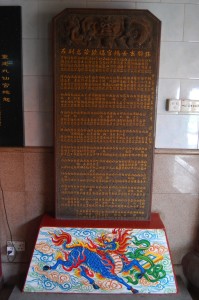
Stele in Peck clan temple with the name “Peck Mah Hoe” at the top, although the character for “Hoe” differs from the one on the tomb. Photo courtesy of Yik Han.
******
About the writer who is an artist :
Alvin Ong is reading fine art in Oxford, and did architecture at the National University of Singapore. In 2004, he was the youngest winner of the UOB painting of the year award at the age of 16. He had his first solo exhibition at 17, in the presence of His Excellency President S R Nathan.
by
Cherlyn Lee Suet Yean
I am a Junior College student who loves history and writing poetry. To me, history is a grand story with so many interesting details waiting to be discovered. In my free time, I love taking long walks around Singapore, letting my feet absorb the atmosphere of different places. I learn so much about Singapore’s history that way.
Naturally, I am interested in Bukit Brown because it is full of history. In fact, I went there earlier this year. But amidst all the tombstones, there was one that held a special resonance for me—the tombstone of Khoo Seok Wan. He was a poet and a scholar, and his life story is particularly fascinating because it contains all the vicissitudes of life.
I became interested in visiting Khoo’s tombstone after I attended an excellent exhibition on him at the National Library. He was born rich but became poor, and died of leprosy. But what really struck me was the beauty and immediacy of his poems, written in classical Chinese style. He is refreshingly honest about his poverty, and his poems chronicle details of his daily life very poignantly.
I suppose I was also was able to identify because I write poetry. I enjoy writing poetry because I get to express myself, and it is a way to channel my emotions. So I decided to visit Khoo’s grave as a pilgrimage to seek inspiration, and to pay homage to a great poet.
For me, the poem of his that I loved most was “Reflections on Building my Grave”. It is by an immigrant who has reconciled himself to the fact that there is no return to the motherland, and his characteristic honesty (with himself) can be seen. He also reconciles himself to inevitable change, and the line “年年新綠到天南“, as much as it describes how grass will grow yearly around his grave, is a statement that accepts change. This is particularly fitting given the change that is happening now, with a road being constructed through Bukit Brown.
In fact, I recited this poem by his tombstone because it felt right to do so, like completing life’s cycle. In his acceptance of dying in a foreign land that has become home, there is perhaps a larger acceptance of change. Given that the highway will be constructed through his tomb, it is perhaps a way of sending him to his final rest. And this is fitting because of the way he stoically endured through the vicissitudes of life with courage and dignity.
This is my tribute to Khoo Seok Wan:
Visiting Khoo Seok Wan’s Grave
As I enter, a tripod covered with verdigris promises
That if I pause long enough, its invisible
Camera will capture me against a hill of tombs.
This afterimage will bewilder passing cars.
At Khoo’s burial mound I recite
“Reflections on building my grave”.
Translated, its crow-squawked syllables
Hover in the somnolent air. A creased map
Guided me here, amid the river of red
Inscriptions I cannot read.
The highway blueprint that sent in
An army of excavators must have been
A summons from the dead. Otherwise I
Would not have come to you
With a broom and a book of your poems.
“Reflections on Building my Grave” by Khoo Seok Wan
(translated by Shelly Bryant from the NLB exhibition)
in sea and on hills
little space even for my abode
how then may these buried bones
leap over the Sword Pond
even were you to call a third time
I will have no hope of rising
from Singapura’s soil [Xing zhou]
when I fall, at last, into repose
a petal brushes my headstone –
another butterfly repeats life’s circle
yet even in these grave markers
styles alter with time
like grass growing anew
in its season
with each passing year
changes again touch
our southern home
Editor’s note: Khoo Seok Wan was exhumed on 12 March 2014, with his grandson and his great grandsons in attendance.
By Sugen Ramiah
The Qing Ming festival, or tomb sweeping day, is observed by the Chinese worldwide. It is a day for them to pay homage to their ancestors, either by visiting graveyards, columbariams or ancestral tablets in ancestral halls.
The actual day falls either on the 4th ot 5th of April, but families have a window of ten days before or after the actual day to conduct Qing Ming. This year, I was fortunate to have been able to observe Qing Ming in Bukit Brown and other locations.
Qing Ming, has many stories to its origin, but is mainly observed as an act of being filial and for geomancy (feng-shui) reasons. The Chinese believe that the bones of their ancestors and the lives of the descendents are inextricably connected. For abundance in wealth and happiness, firstly, one has to be filial. Secondly, there has to be a good flow of Chi (positive energy) on the forecourts of their ancestors. During the dry season, the foliage clogs the drainage causing an obstruction to the flow of water. During Qing Ming, the drainage is cleared, to allow the flow of water (Chi) onto the forecourt of the tomb. Qing Ming is also a perfect opportunity for extended family members to get together amidst busy work/family commitments.
Descendents set off as early as first light, to wash, sweep, and weed the tombstones. Inscriptions on the headstones are then re-inked using red or gold paint. A stack of coloured paper or a stone is placed on the headstone to signify that the dead is not forgotten. The paper is also scattered on the mound of the grave. This recalls how an emperor from the Han Dynasty in China could not find his parents’ tomb after he returned from war. He was then told to throw five coloured paper into the air and where they lodged, that was the location of his parents’ tomb.
Two sets of offerings are prepared by the families. First set is for the earth deity by the side – a pair of candles are lit, food and incense offered to the Tu Di Gong who is the guardian of the tombstone. Paper money is also burnt as a form of offering.
Second set is for the deceased – a pair of candles are lit, offerings of tea, fruits, favourite food, and longevity cakes are placed on the tombstone altars. Incense sticks are firstly offered to long departed ancestors and subsequently to the deceased. Incense sticks are placed in an urn and sometimes around the mound, and then descendents wait for the deceased to ‘finish’ their meal Sometimes during the wait, incense sticks are offered to neighbouring tombs – recalling the days of the kampong spirit.
Once approval has been given through the moon blocks or coins, offerings of hell notes and silver paper, clothes, shoes and even latest technological gadgets such as the ipads are burnt for the deceased. Sometimes the required items are packed in a paper treasure box, sealed with the name of the ancestor and burnt for them exclusively. To conclude, tea or any form of liquid is poured around the offering to “secure” the area of the burnt offerings, so as to avoid invasion by other wandering spirits.
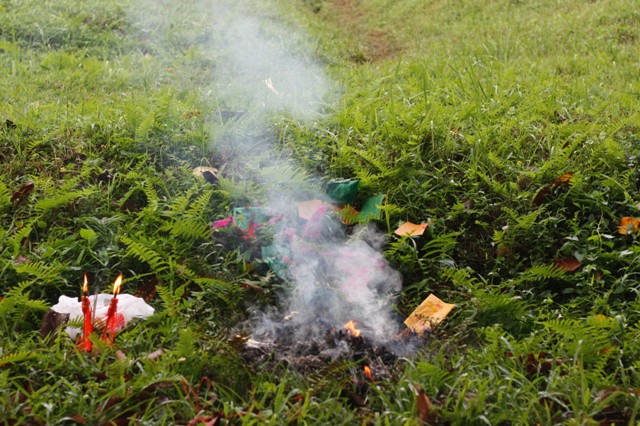
Simple offerings of tea and candy by a woman who comes here yearly to pray for her infant aunt who died during the war. The infant’s burial was not registered so the exact location of plot is unknown.(photo Sugen Ramiah)
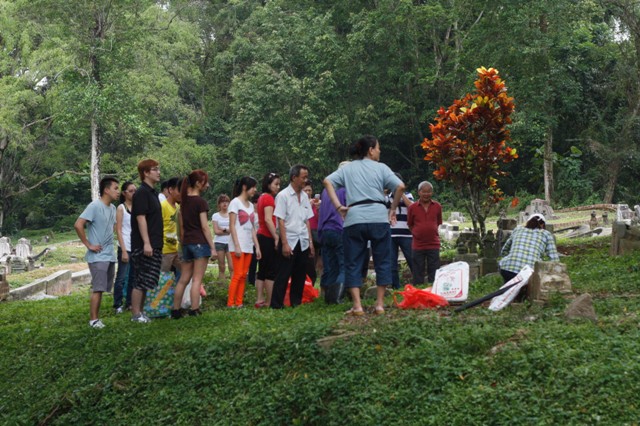
The Ng Family has to charter a bus to transport the entire family for Qing Ming (photo Sugen Ramiah)
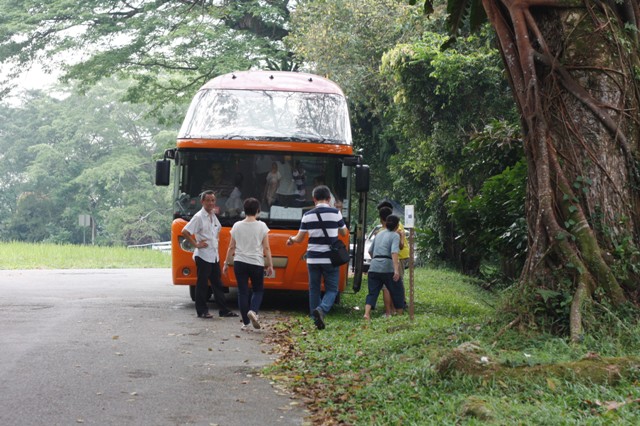
The Ng Family has to charter a bus to transport the entire family for Qing Ming (photo Sugen Ramiah)

A young boy from the Pek Family, who looks forward to Qingming annually, as he gets to visit the tomb of his Lau Yeh (Great grandfather) and meet his cousins. Photo taken at the tomb of his Great Grand Father at Hill 3 (photo Sugen Ramiah)
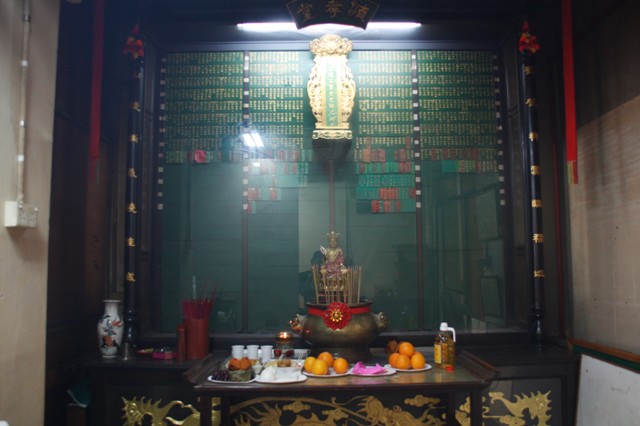
Descendents observing Qing Ming in a less taxing environment at the Cantonese Ancestral Hall of the Singapore Hok San Clan Association (photo Sugen Ramiah)
It has been a rewarding experience, to learn from family members on how they up hold traditions that has been handed down to them. All they hope is that these traditions will be carried on by the generations to come and that their ancestors will not be forgotten. I will close with a quote that is close to my heart.
“To acknowledge our ancestors means we are aware that we did not make ourselves that the line stretches all the way back, perhaps to God; or to Gods. We remember them because it is an easy thing to forget: that we are not the first to suffer, rebel, fight, love and die. The grace with which we embrace life, in spite of the pain, the sorrow, is always a measure of what has gone before. ” – Alice Walker
***
Sugen Ramiah is a teacher by training and his interest includes observing and documenting Chinese festivals and rituals conducted by temples.
Read his blog posts on Salvation for Lost Souls here and here
Read about the tombkeepers’ Qing Ming here
A personal account by Aylwin Tan who witnessed the exhumation of his grandfather and aunt at Bukit Brown on the morning of Wednesday, 8th January,2014.
***
I received a phone call from the exhumation office about 1.5 hours after I had registered. Picked my Dad up and went directly to the gravesite.
The green tentage is that of my aunt Tan Siok Hwa (aged 10) and the grey is my grandpa, Tan Cheng Moh. Both were killed during a Japanese raid; a bomber scored a direct hit on the bomb shelter where my grandpa had put his entire family, including his close relatives. Apparently, grandpa’s thinking was that they should all stick together and if they all died, so be it.
Their funerals were carried out in haste. A number of traditions were abandoned for fear of being caught out in the open by the Japanese bombers e.g. mourners alighting to perform rites at every bridge along the way to the burial ground.
Mr Lee (the gentleman in yellow boots seen in the first photo) told me that the coffins and remains had disintegrated and had merged with the soil. Not surprising, given that they had passed about 70 years ago. The gravediggers gathered some earth and put it in plastic bags for the purposes of cremation.
I was curious to know how the gravediggers knew that they had dug deep enough to reach the remains. Mr Lee explained that the gravediggers would know once they reached a flat surface as this was the bottom of the coffin.
The gravediggers were also able to tell that my aunt died when she was a child. If you look at my aunt’s grave, you can see a ‘step’ indicating that the coffin was shorter than an adult’s.
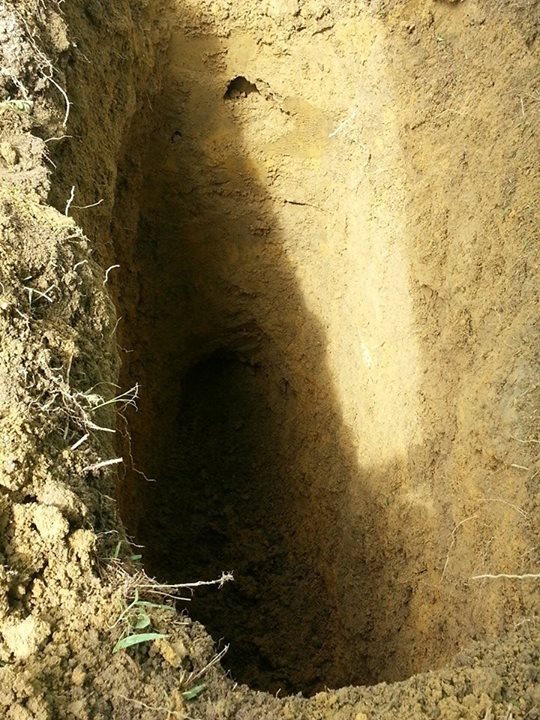
The grave of grandfather dug until a flat even surface was reached, where the coffin had been laid (photo Aylwin Tan)
I was worried that Dad would not be able to negotiate the uneven terrain to the grave sites but the path worn out by the gravediggers proved manageable. Mr Lee told me that these gravediggers are the last of their kind in Singapore.
Dad spent some time telling his story to the gravediggers while I sorted out with Mr Lee the items found in the graves. Dad’s chair was provided by Swee Hong, the company that won the exhumation tender, a testimony to their planning and attention to detail. Also, you can see how they used the umbrellas to shield the boxes from the sun.

Umbrellas shading the remains from the sun as required by traditional practices. Aylwin’s father (seated) chatting with the grave diggers (photo Aylwin Tan)
The gravediggers recovered a chain and part of a bowl from my aunt’s grave. The bowl was probably used in the funeral rites. Mr Lee asked if I would donate them for research. I shall have to ask my elders’ permission first.
My grandpa’s grave yielded a bullet and a piece of metal which looked like a cone with the top portion cut off. I had to surrender the bullet as it was not a spent round. The gravediggers surmised that the metal piece came from the bomb but I wonder where the bullet came from. Dad said that the metal piece was not the cause of grandpa’s death; a beam had fallen on grandpa’s head and cracked it open. Death was instantaneous. The sight must have been extremely traumatic for the family. Dad was only 11 or 12 then.
One unexpected development came about when Dad suddenly said that my great grandfather was also buried somewhere in Bukit Brown. Dad did not know his name or the location of the grave site. Apparently, only one of grandpa’s brothers had this information and he had since passed. According to Mr Lee, great grandpa’s remains will be exhumed and disposed of if unclaimed after a period. Mr Lee also said that there was still hope if someone in my family could remember great grandpa’s name as the tombstone would surely state grandpa’s name. I’ll try my best to ask my relatives but am not very hopeful.
I will miss the 2 “Yodas” guarding grandpa’s grave. The other 2 guards look kind of effeminate.
The left panel of the tombstone lists grandpa’s sons and daughters. Dad is ‘Geok San‘, which means ‘jade mountain’ in Chinese. In accordance with Chinese tradition, the sons and male cousins in the same generation have the same identifying name. In my Dad’s generation, the name is ‘Geok‘. In mine, it is ‘Wee’, which means ‘great‘ in Chinese. I understand that these names are predetermined by the Chinese Almanac.
The exhumation ended on a quiet note. After I had given written confirmation of the items from the graves that I had retained, I was given printed photographs of the two grave sites and that was it.
I was very impressed with the professionalism of the Swee Hong staff. They were attentive to my requests and sensitive to religious aspects of the exhumation. They worked fast but were in no hurry, allowing claimants all the time they needed to carry out their religious observances. Thanks to them, the exhumation process went smoothly.
– Aylwin Tan-
Additional Information : Both grandfather and aunt died on 18 Jan 1942.
Grave of Tan Cheng Moh 陳青茂 #769 (photo credit The Bukit Brown Cemetery Documentation Project )
Grave of Tan Siok Hwa 陳淑華 #763 (photo credit The Bukit Brown Cemetery Documentation Project)
Editor’s note: We would like to thank Aylwin Tan for giving us permission to reproduce his personal account on the blog. If you are a descendant who has ancestors staked for exhumation, please share your story with us.
Email us: a.t.bukitbrown@gmail.com
Han Yi Jie 寒衣节
By Victor Yue
4 November, 2013
Han Yi Jie, which means “warm clothing event”, is a Chinese tradition when the start of winter reminds the people that their ancestors and departed loved ones would also be experiencing the cold. And so, they make offerings of food and warm clothing for them.
In Singapore, where it is always warm (hot in fact), such a tradition hardly exists. But, Xuan Jiang Dian 玄江殿, a Chinese temple dedicated to Xuan Tian Shang Di (玄天上帝), known as God of the North, continues with this tradition. For a a long time now, every year without fail, on the first day of the tenth lunar month (moon), this temple, with its devotees would visit Bukit Brown Cemetery to make offerings to the wandering souls. To the Chinese, the first day of the 10th moon marks the beginning of Winter. (Wandering souls are souls of the departed who do not have anyone (descendants) making offerings to them)
This year the first day of the 10 lunar month, fell on 3 November. As has been their tradition, members of Xuan Jiang Dian 玄江殿 went to Bukit Brown Cemetery to make offerings to the wandering residents of the cemetery. This year saw a bigger offering. Could there have been an increase in the number of wandering souls? Devotees of the temple contributed warm clothings, money (in the form of joss papers) and food. Some Brownies also contributed towards the offering of the warm clothings (in the form of paper robes).
This year, Shan Cai Tong Zi 善才童子, through a spirit medium, came along to offer sermon (dharma) to the invited souls at the gathering by the Ole Rain Tree. Shan Cai Tong Zi is a deity who is one of the 500 assistants to Guan Yin.. In S.E,Asia, he is a popular deity who is trance by spirit mediums. He is only 3 years old and the older folks, especially old aunties, like him, because they can be less formal, unlike the warrior deities.
Shan Cai Tong Zi, through his ancient Hokkien and mudras offered blessings to the gathered souls. Offerings which ranged from various kinds of kueh kueh, joss sticks, coins to rice were made.
Offerings which ranged from various kinds of kueh kueh, joss sticks, coins to rice were made.
Before the start of this event, respects were also accorded to the guardians of the hills.
After the blessings and offerings to the wandering souls, it was time to bless the living souls who gathered to contribute towards this event. Good health and good luck were amongst them being blessed onto the members gathered. Members were offered the five different beans (known as Gor Tao 五豆 in Hokkien) to bring back home. A big “Huat Kueh” (a traditional Hokkien cake made with yeast and flour through steaming) that was made in the temple by members for this event was offered to all present to take bit to eat, for good luck and “jia peng an” (吃平安) meaning eating to get the peace”)。
With the impending construction of the 8 lane highway through Bukit Brown, this is likely the last time that Han Yi Jie will be conducted at the ‘ole rain tree. But we still hope it will not be the last at Bukit Brown.

Lighting the way by the barricades erected in preparation of the start of exhumation (photo Andrew Lim)
The Hindu Day of Remembrance
by Sugen Ramiah
1 November 2013
Like the Chinese who observe the annual “qing ming” or tomb sweeping festival in April, the Indians also honour their ancestors with a visit to their ancestors tombs on the Hindu day of remembrance. It takes place the Sunday before Deepavali, the festival of lights which falls on 2nd of November, Saturday.
On Sunday 27th November, I visited the Hindu cemetery located in Lim Chu Kang to pay respects and place offerings on my ancestors’ tombs.
My grandparents to date have a total of 125 descendants but sadly only 4 turned up, two cousins, my brother and myself.
The trip usually lasts for about two hours, as we’ll clean up five tombs, four in the Hindu Cluster and one in the Catholic cluster. Simple offerings including fruits and sweetmeats were placed on a banana leaf. With the lighting of an oil lamp and incense, the Indians remember their dearly departed.
In the evening at home, the entire family would gather. A feast that consists of eight dishes – chicken, mutton, eggs, fish, prawns, squid, crabs and vegetable, together with fruits, sweetmeats and Indian Peranakan delicacies such as the “kueh wajek”, will be laid before portraits of the ancestors. New cloths would be placed beneath the portrait, incense lit and finally the family members would eat the food that were offered.
Traditionally our forefathers from India were cremated , so there was never a need for tomb stones like the Chinese, Muslims and the Christians. The deceased were usually cremated within the day of death. But if they were wealthy, they would be given a burial. In the Hindu custom, the dead is also remembered on their death anniversary, known as a “theethi’”where a “mocham” lamp (light of liberation) is lit as a sign of remembrance.
Hindus have more than one festival to remember and honour their ancestors. On the full moon of the sixth lunar month of ‘Puratasi’ which falls in September/October, there is the ‘Mahalaya Amavasay’ also known as the fortnight of the ancestors. Hindus pay homage to their ancestors and offer prayers for the repose of their dearly departed at temples.
Some Hindus commemorate the dead during the Matu Pongal, on the second day of the “Pongol” Harvest Festival. The Indian Peranakans, known as the Chitty, celebrate the eve of Pongal with Bhogi Parachu – the ancestral worship festival. Since there were a few festivals to remember the dead, the local community here and in Malaysia decided that the Sunday before Deepavali will be the day of remembrance.
My grandfather, a wealthy merchant born in 1884, came to Singapore and contributed greatly to the Indian community of Singapore in the 1900s. He started the first dairy business here and contributed to the Sri Mariaman Temple in South Bridge Road He married my grandmother who was a Chitty- Indian Peranakan – from Melaka(Malacca) and she was the matriarch of the family. The honorary title is currently held by my aunt who is 85 this year.
As a Brownie, I have been moved by the descendants who return every year to Bukit Brown during “qing ming” to clean the tombs and pay their respects. I am also sadden by the tombs that lay neglected, which have been forgotten, and I hope more descendants will come forward and reconnect with their ancestors.
I am blessed and grateful to the friends/volunteers of Bukit Brown, who have kindly showed me how to appreciate and understand my own heritage and to be proud of who I am. This was the first time, my brother marked the remembrance day for our grandparents and it was for him an eye opening and moving experience.

Grandfather’s tombstone at the Hindu Cemetery, simple offerings of fruits, sweetmeats and roti prata were offered on top of a banana leaf (photo Sugen Ramiah)
Sugen Ramiah is a teacher by training and his interest includes observing and documenting Chinese festivals and rituals conducted by temples.
Read his blog posts on Salvation for Lost Souls here and here
Dateline” 21 October 2013
The carvings on the tombs at Bukit Brown are commonly drawn from the 4 Chinese classics. Brownie Yik Han spotted one particular carving on an altar table which intrigued him.
His observations of the characters depicted in the tableau taken from the Romance of Three Kingdoms and what they represent:
Instead of the usual set of suspects this tableau has a rather unique combination of figures which I have yet to come across in other tombs.
The one in the middle seems to be Zhuge Liang from his garb and feather fan. On the right is almost certainly Shun and the white elephant which helped him till his fields. And I guess the one on the left of Zhuge Liang is Liu Bei as he looks rather regal. Now, each of these characters exemplify a certain virtue: Zhuge Liang – loyalty (忠), Liu Bei – benevolence (仁),Shun – filial piety (孝), so there we have part of the traditional set of virtues 忠孝仁义, the last being righteousness which is as close to the meaning in chinese as we can get in a word.
If the martial figure to the right of Zhuge Liang represents 义, the question is who can this be as it certainly is not Guan Yu, the usual poster boy for that virtue. Of course, this interpretation assumes the two figures at the extreme left are calefaire.
Editors note: If you would like to weigh in on the mysterious characters which have not been clearly identified, please add your comments on this post.
Your can read more about other tomb carvings by Yik Han on The Wayang in the Tombs , Romance of the Three Kingdoms,
.
At Bukit Brown, one often finds couplets on the “pillars” of the tombs. They embed auspicious meanings and also tributes to the departed.
The tomb of Chen Yen Soon has a pair which speaks of the rewards which await those who live a good life.
为善百世興 Hundred years of prosperity for kind acts.
積德千年好 A good thousand years for those who accumulate good deeds.
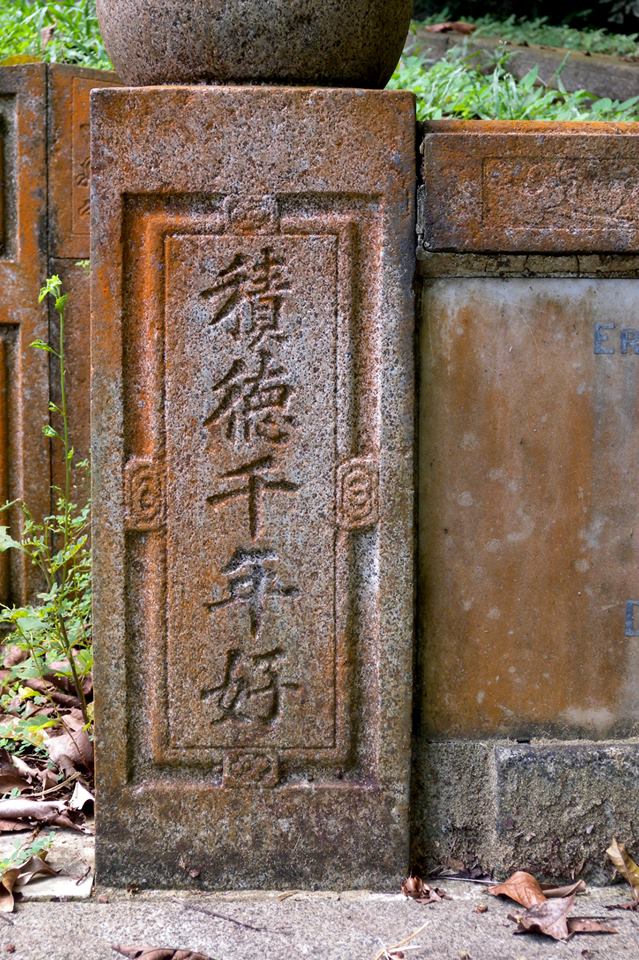
積德千年好 A good thousand years for those who accumulate good deeds. (photo Khoo Ee Hoon)
An inscription found in a temple in Silat Road on a photo of the Earth Deity or Tua Pek Kong, evokes the same sentiments.. Brownie Fabian Tee summarises:
The couplet reads fortune with virtue inspires respect from a thousand families (from many) the uprightious shall inherit the earth as deities for innumerable (ten thousand) generations. When read together, it’s an allegory to 福德正神。
More examples of couplets here
The Dancing Lanterns by the Youths of Bukit Timah Seu Teck Sean Tong
Sugen Ramiah
Apart from satisfying the hunger of the wandering spirits and entertaining them with boisterous live stage performances of the Getai, the seventh lunar month is also meant for the living. Business owners, wet market and hawker center associates, during this period to pray for peace, smooth sailing and thriving ventures. The members of the Tanglin Halt Wet Market invited the Bukit Timah Seu Teck Sean Tong to conduct their annual seventh month rituals, which was held on the twenty ninth day of the seven lunar month (3rd of September 2013).
Akin to the Teochew rituals at Chui Huay Lim Club, an entire day was spent to fulfill the needs of the wandering spirits. As dusk drew near, the focus was diverted to the living; as they recited the guan yin sutras, asking for bountiful blessings upon the supplicants. One of the highlights of the evening was the “dance of the auspicious lanterns” or also known as ‘kee hock pau teng‘ in Teochew
These are the common red lanterns found suspended at entrance of the house, oval in shape and adorned with golden tassels. In reality, there is no underlying dogma to this presentation; however this is done to extend their (the temple) appreciation to the organizers who engaged them and to amuse them with a little folklore.

The common red lanterns which are oval in shape, adorned with golden tassels which can be found hanging at the entrance of a house (photo Sugen Ramiah)
The performance began with the dimming of the interior lights of the temporary altar, to create the perfect ambiance. The youths of the temple, draped in white robes with green sashes across their waist, then marched in with the new lanterns.
It was accompanied by a beautiful Teochew repertoire of strings and percussion. As the tempo gradually increased, the youths sprang into acrobatic actions with their lanterns creating rhythmical movements. Every single movement found expression in their faces. The radiating positive energies exuded by these young men were bound with the lanterns, thus transforming them into auspicious items.

This is the energy that burns in the passionate youths that makes the lanterns auspicious ( photo Sugen Ramiah)
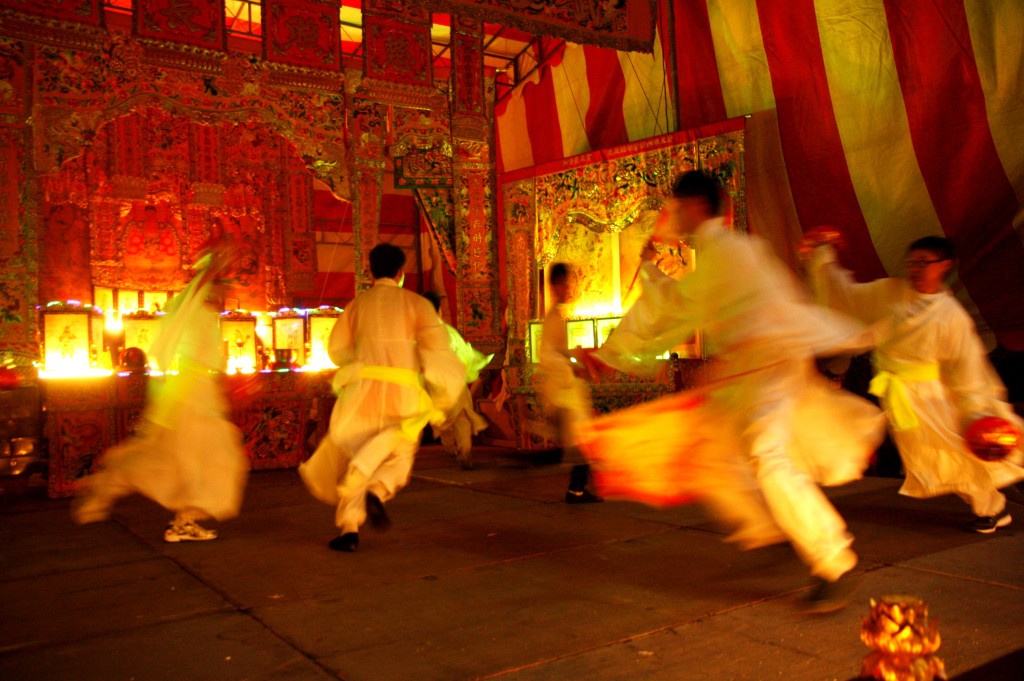
This is the energy that burns in the passionate youths that makes the lanterns auspicious (photo Sugen Ramiah)

The final pose struck at the end of every piece, Kelvin (front) Yishun (left) and Matthew (right) (photo Sugen Ramiah)
Flags of various colours were also carried in this ritualistic dance. These twelve pairs of auspicious lanterns and flags were then placed for bidding during the auction dinner the following day.
The ceremonial dance concluded with a roaring ‘huat ah’ by the youths as the organizers received and hung the lanterns on the bamboo poles. These lanterns purchased during the auction will be taken home and will be returned the following year.
Sugen Ramiah a teacher by training, has been observing and documenting Chinese festivals and rituals conducted by temples for the past one and half years.
More on the Hungry Ghost Month from Sugen here and here .
by Sugen Ramiah
The rituals (Part 1) by Xuan Jiang Dian (Tortoise Hill temple) had begun with the gathering of lost souls, followed by purification and the granting of salvation. Now what remained was the sendoff, the rites of passage for the souls to transcend into the final phase – reincarnation.
As the temple volunteers busied themselves with preparations, family members streamed in, with offerings of food, drinks and flowers – a final meal for the souls. The menu included local delights such as the ‘apom’ (coconut pancake) and ‘roti prata’ with curry.
Taoist priests draped in beautifully woven majestic vestments walked through the rows of tablets chanting the scriptures.This was followed by the tossing of offerings (which had been blessed) to the “yeow kui (literally hungry ghosts). Offerings such as sweets, flowers, fruits, joss papers, a whole chicken and even pieces of pork belly were thrown before a group of supplicants waiting to catch them.
With the altar table emptied, the celebrants then performed “mudras” – a series symbolic hand gestures which are believed to be imbued with energies.
As dusk approached, we were treated to an uncommon sight of the ‘Ku-Dong’. The ‘Ku-Dong’ is a pair of big headed dolls, identical to the common ‘Dua Tow’. The commonly seen ‘Dua Tow’ has a gleaming smile and often bounces jovially to the sound of the ‘gongguan’ (percussion troupe). The Ku-Dong however, expresses extreme grief with tears streaming down its rosy cheeks.
The Ku-Dong crawls on its knees and wails plaintively to the sorrowful tune of a folk song. In Chinese funeral customs, the mourners, especially the women kneel beside the coffin and lament. It is an expression of intense grief, respect and loyalty to the deceased.
But has anyone grieved over the innocent – victims of massacres, of infant mortality and those whose bodies were never claimed and ultimately not given a proper burial? These acts of remembrance, assures closure for the souls. Having heard expressions of grief for their death, they can now move on.
They are transported on the ‘Ship of Compassion’ that saves sentient beings and ferries the souls to its final repose. An effigy of the Ship was positioned at the entrance of the tentage. Family members were invited to bring their ancestral tablets and place them neatly in the lower deck. Those tablets without family members, like the tablet dedicated to the souls of Bukit Brown, were reverently carried by the volunteers of the temple. Once the decks were filled and all “guests” were on board, the ‘Ship of Compassion’ was ready to set sail.
By this time the procession to accompany the souls had already lined up and the fifteen foot effigy of ‘Da Shi Ye’ (King of Ghosts) was carried together with the ‘Ship of Compassion’. The sending off procession led by the gongguan , took a longer route as the ‘Da Shi Ye’, wanted to ‘inspect’ the neighborhood.
Five fully loaded chartered buses arrived at East Coast Beach. The ‘Ship of Compassion’ was then carried to the shore, and piled with paper silver and gold. Two lanterns and bundles of joss sticks were placed and finally lit. As the flames illuminated the darkness, thoughts of impermanence clouded my mind.
The three day intensive event drew to a close when we returned to Bukit Merah to send off the King of Ghosts. Paper treasure chests, prepared as departing gifts were place in an orderly manner inside an enormous cage for burning. The effigy was finally placed in the center, and ignited.
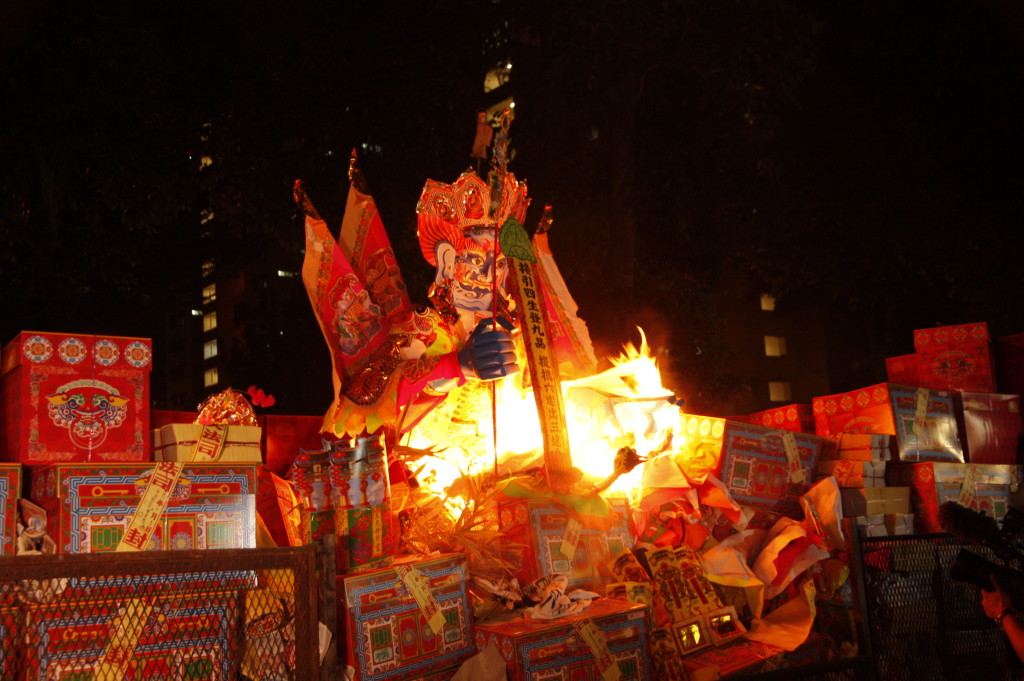
The King of Ghosts and the treasure chest paper offerings – brings to a close the salvation for lost souls with Xuan Jiang Dian (photo Sugen Ramiah)
For me, it has been a rewarding experience, to understand the concept of salvation in an afterlife. As paper burned into ashes and darkness turned to light, I prayed that the lost souls had now found, peace.
Sugen Ramiah a teacher by training, has been observing and documenting Chinese festivals and rituals conducted by temples for the past one and half years.

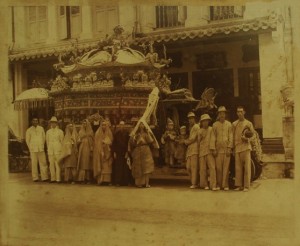
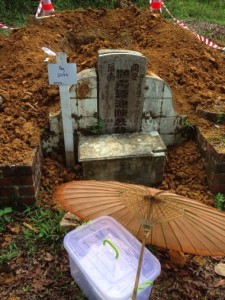
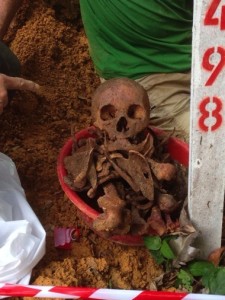
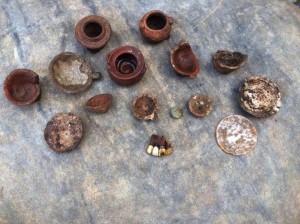

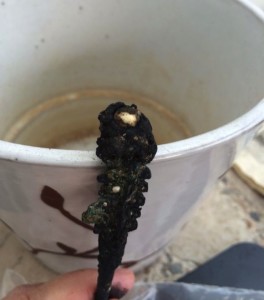
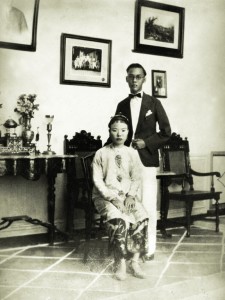
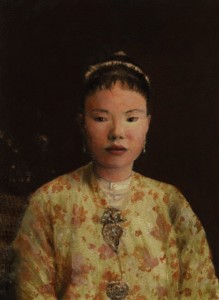


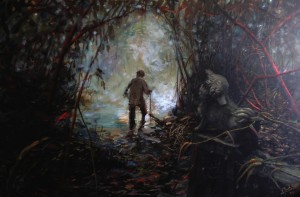
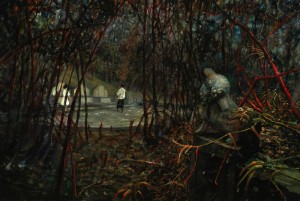




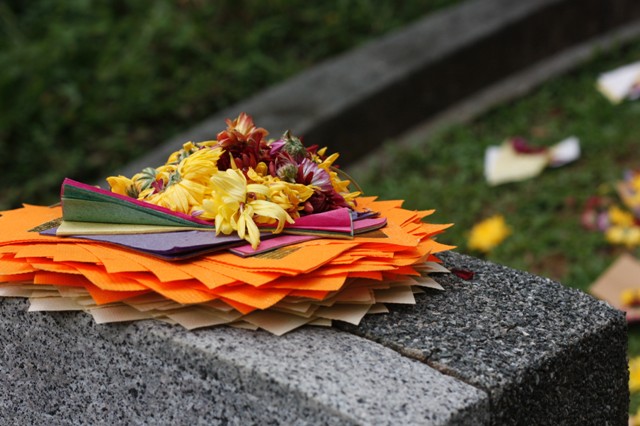





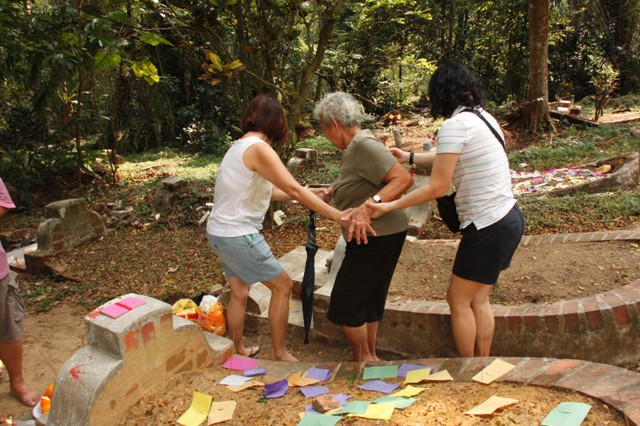


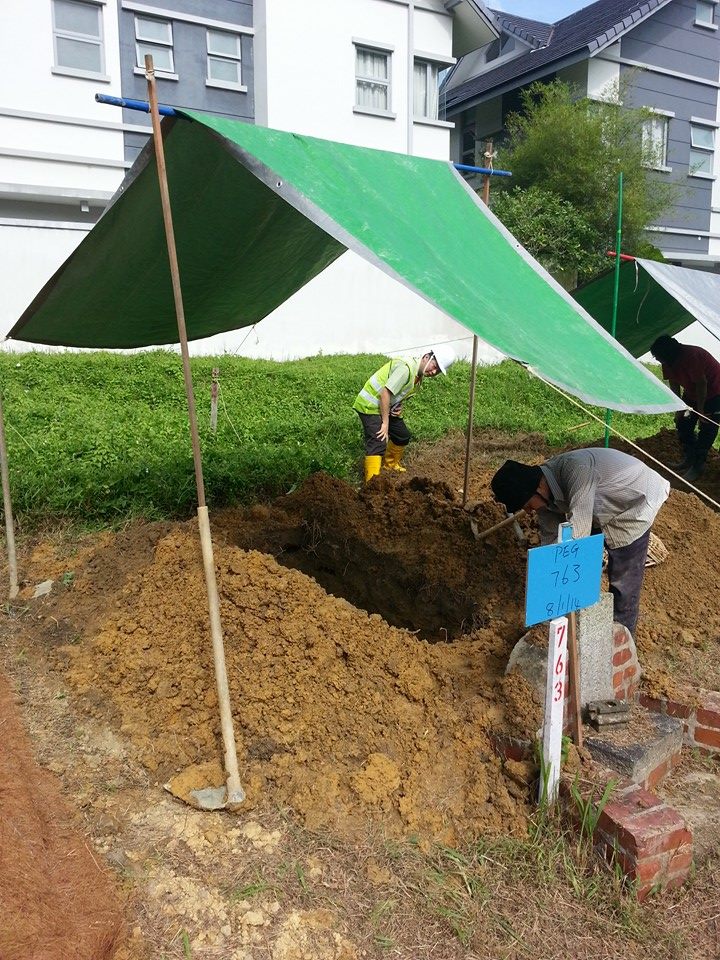
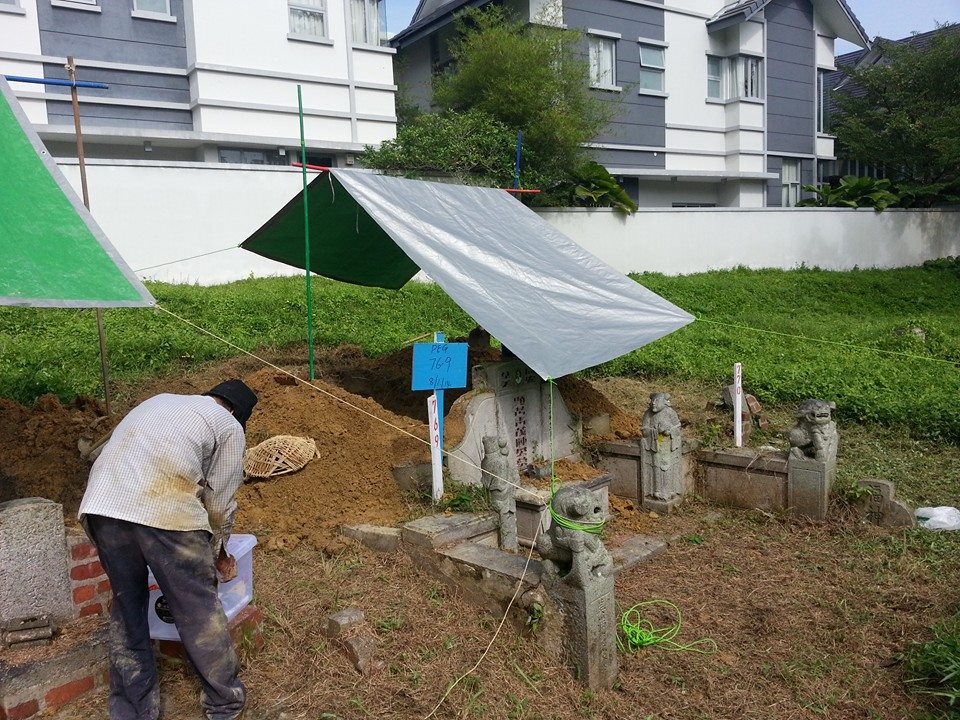

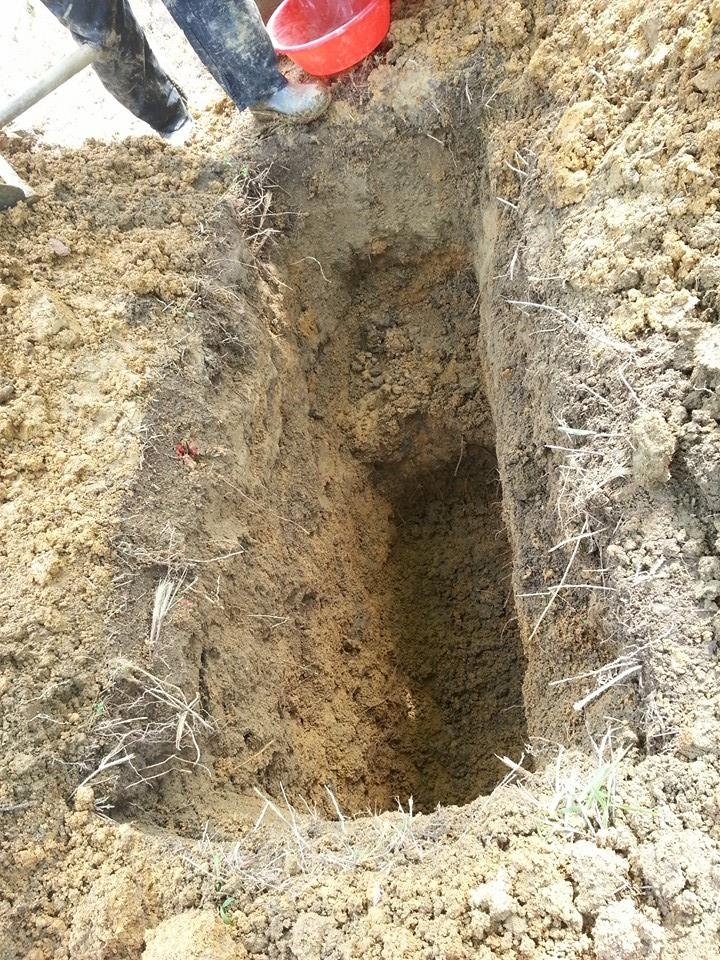
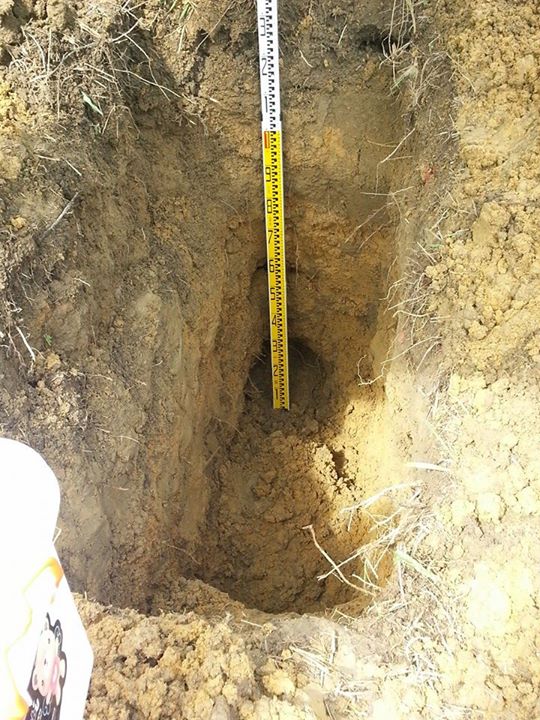

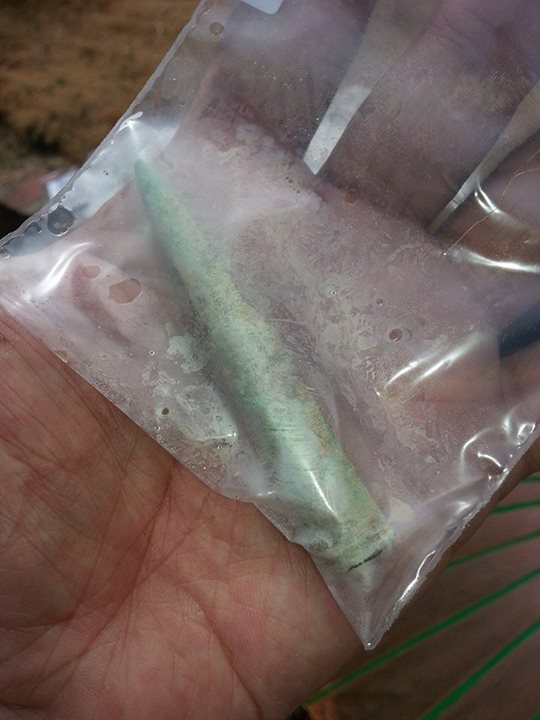
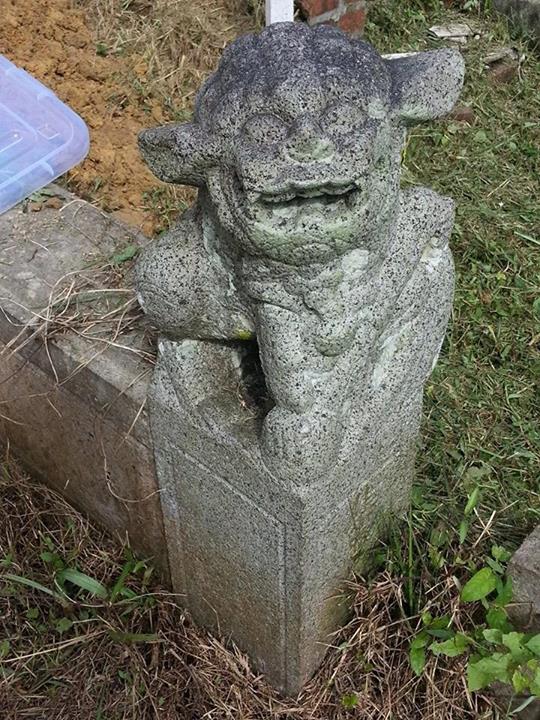
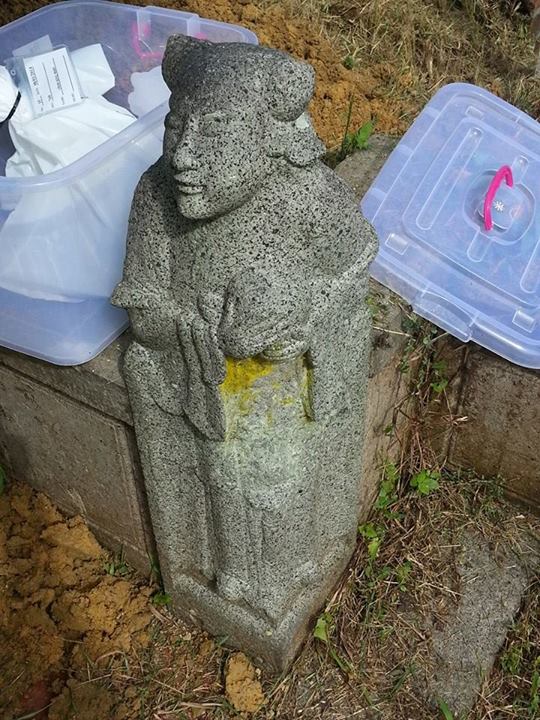
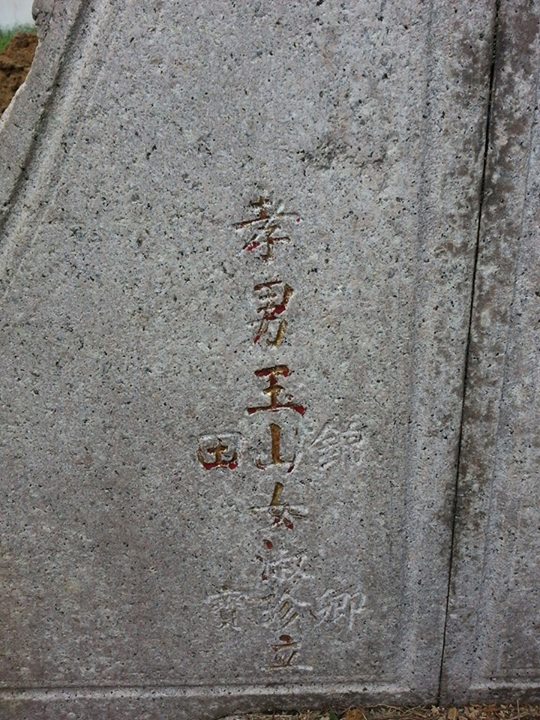

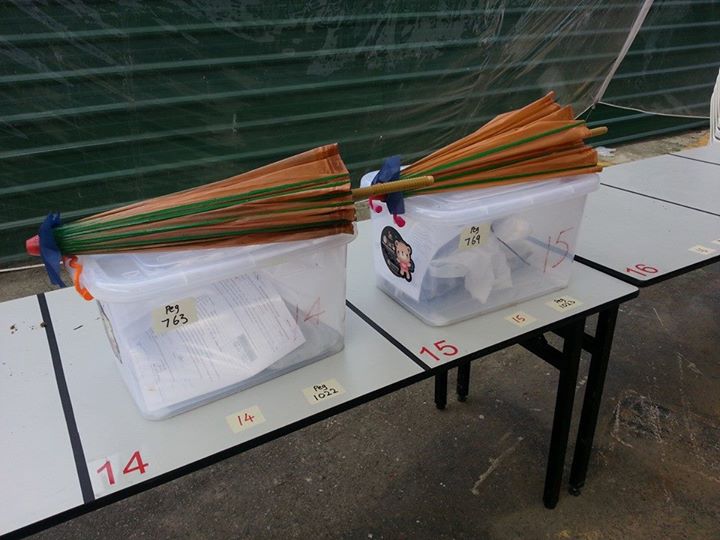
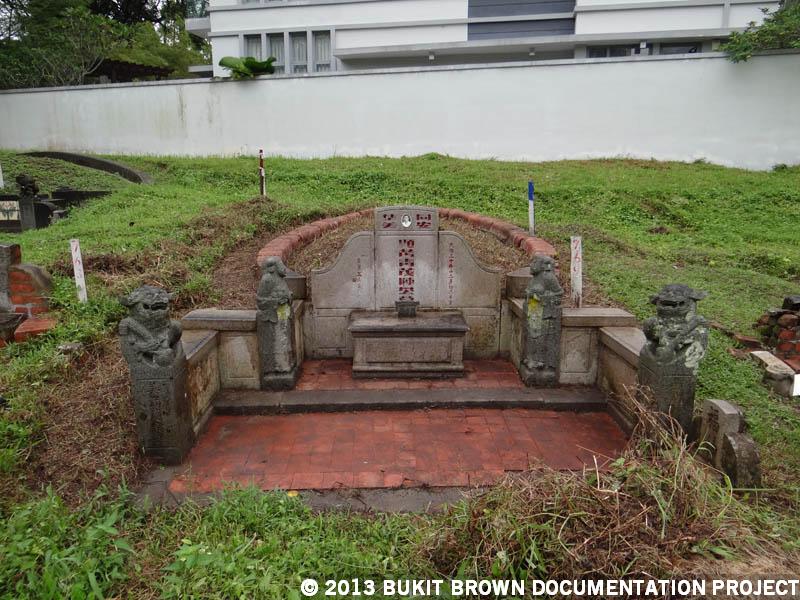
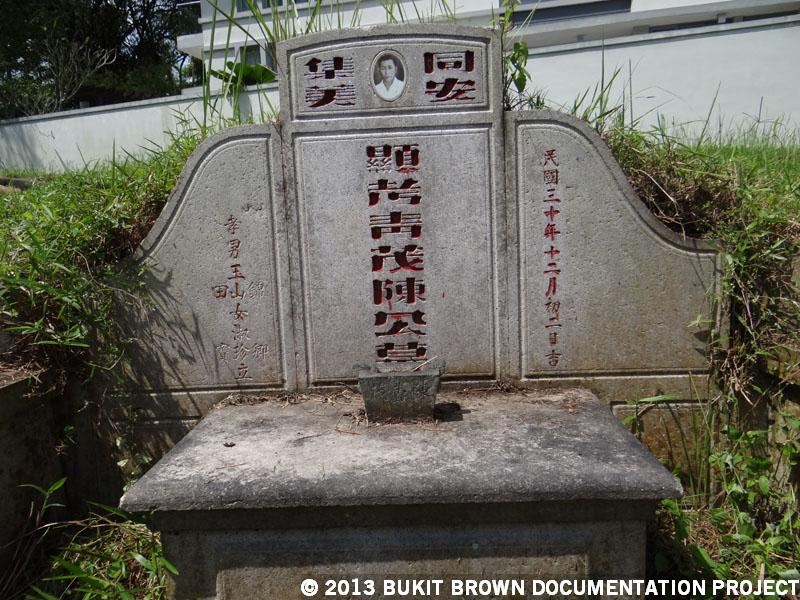
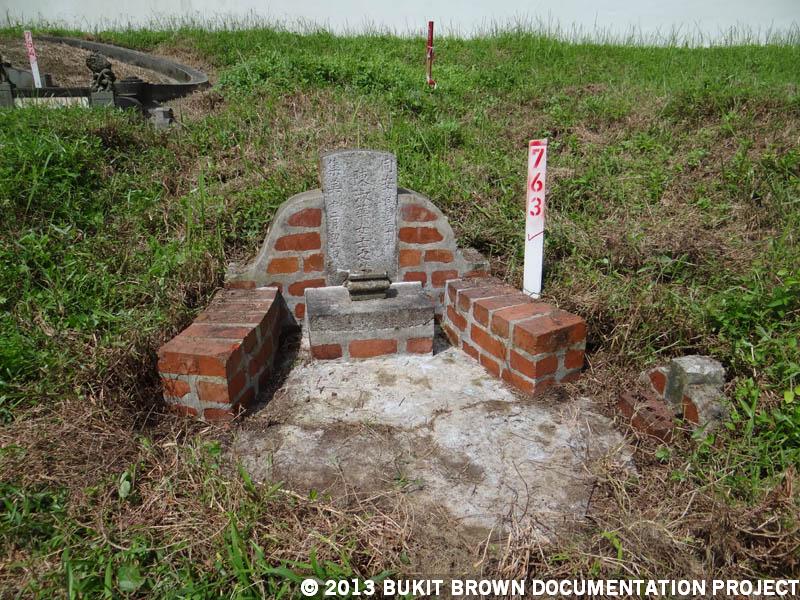

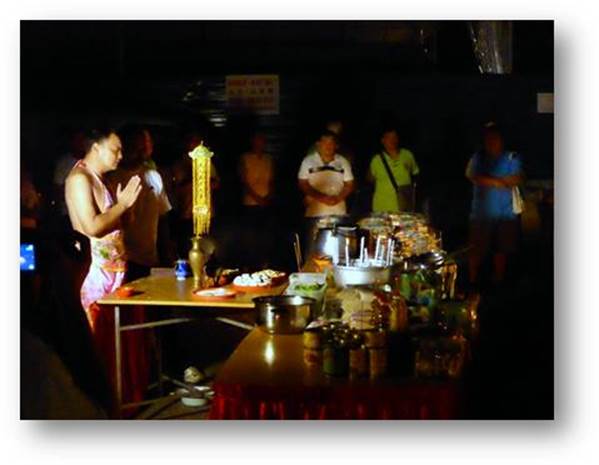
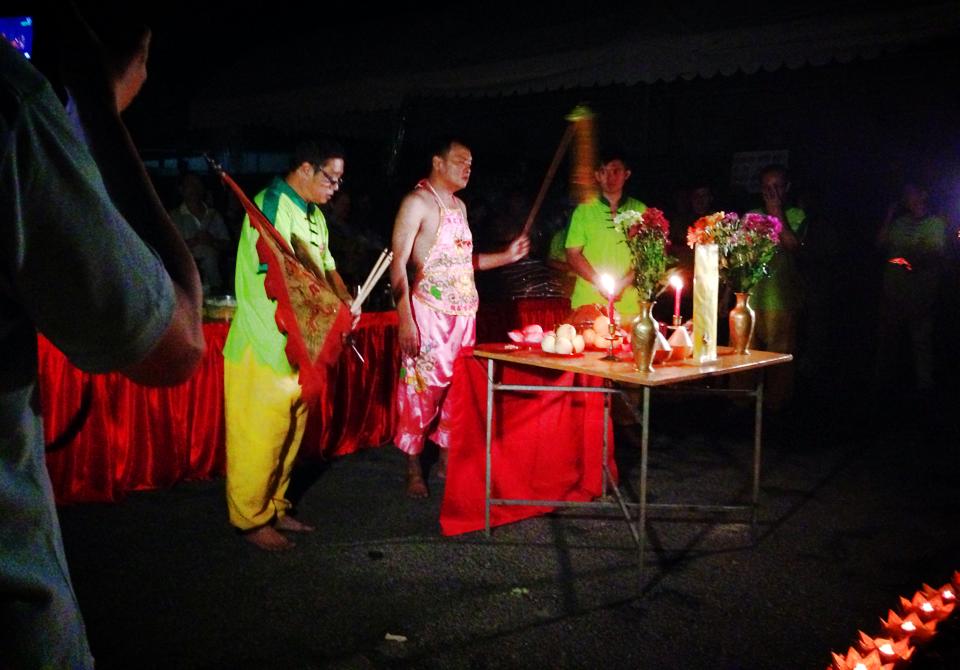
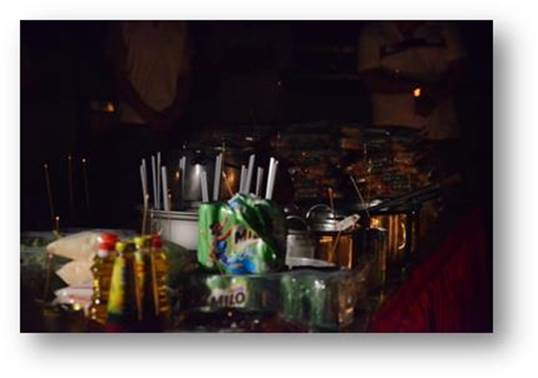

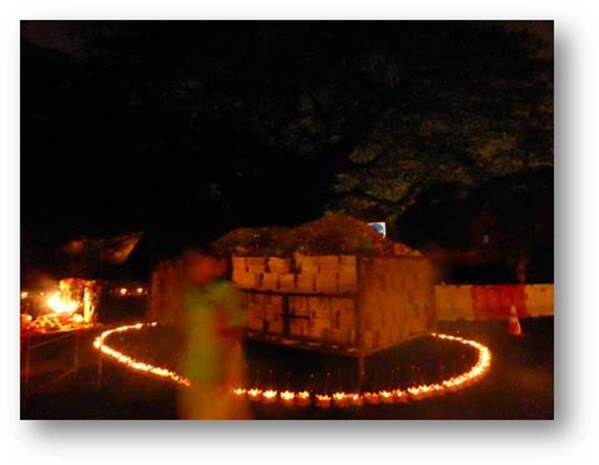
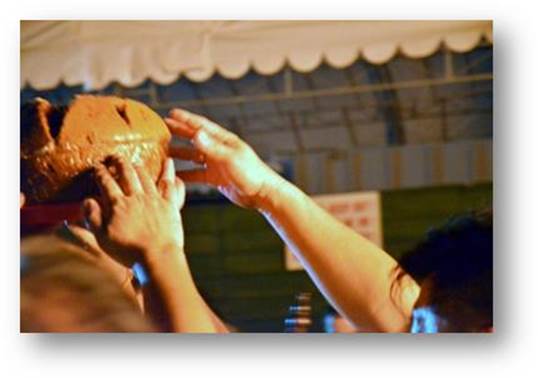
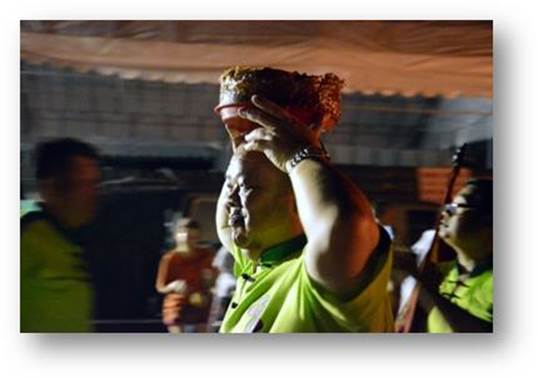
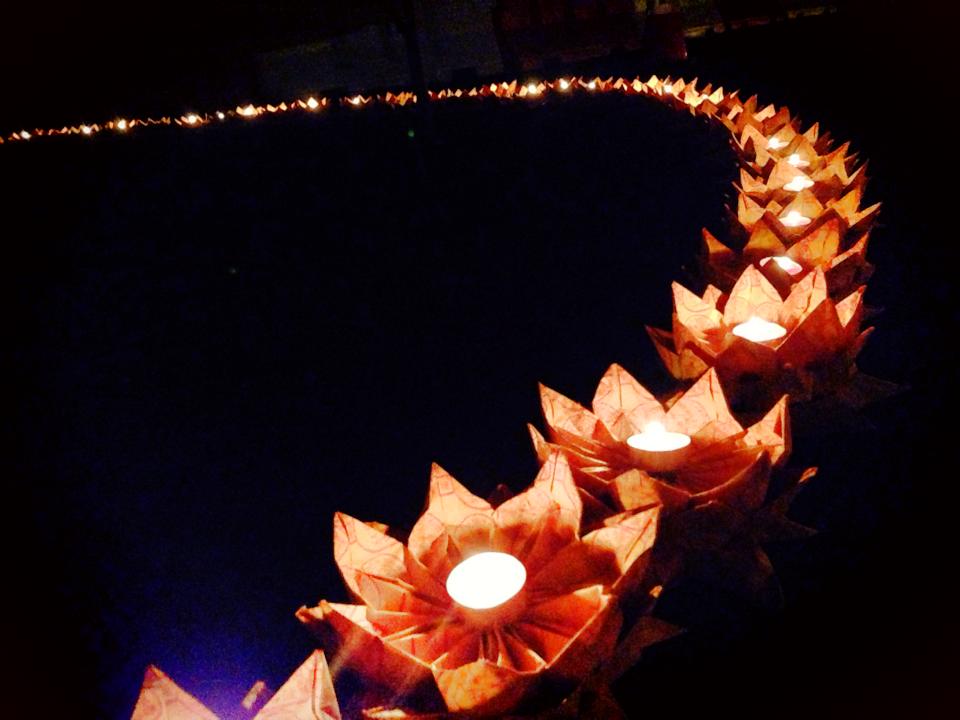

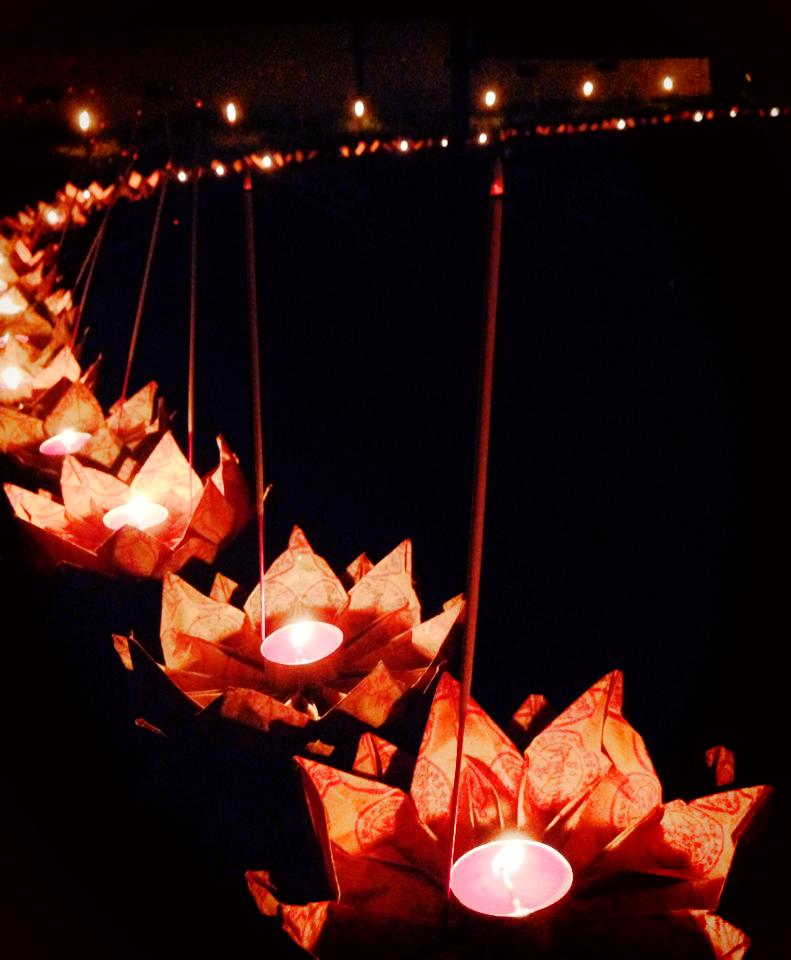
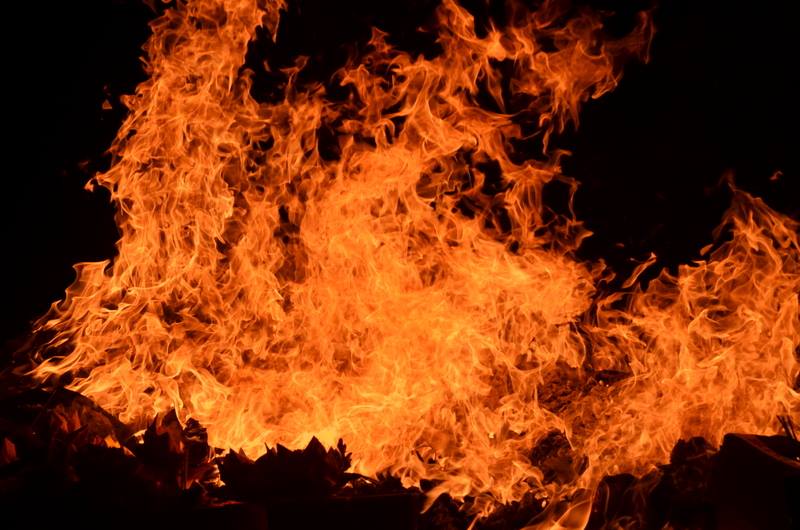








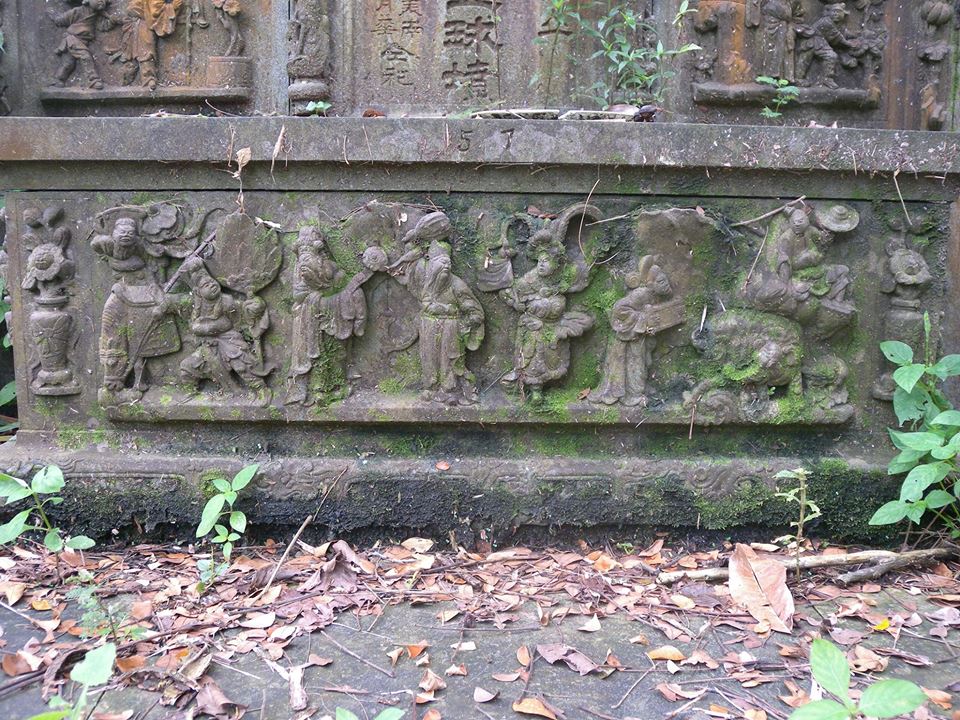
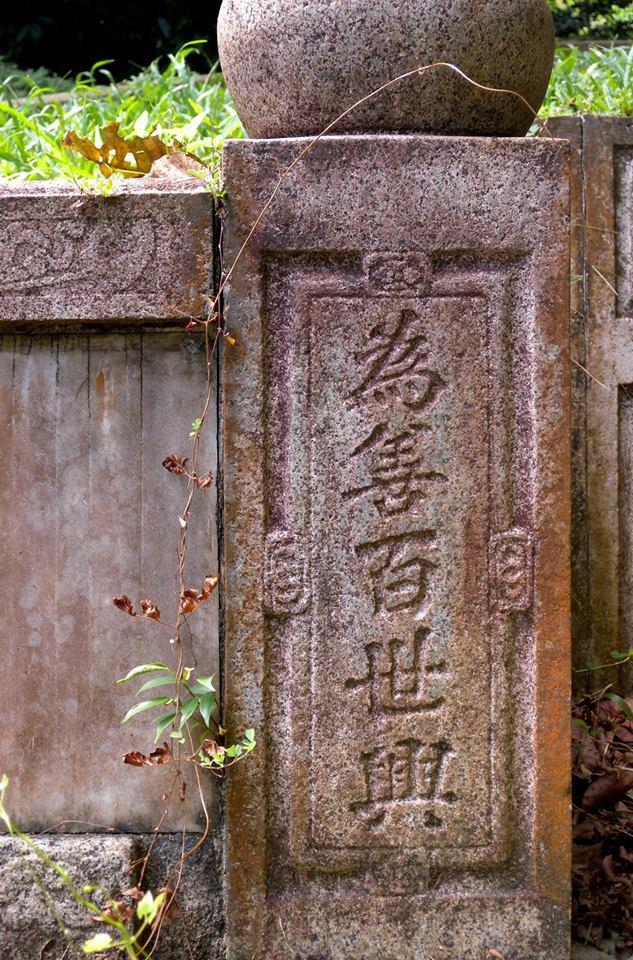
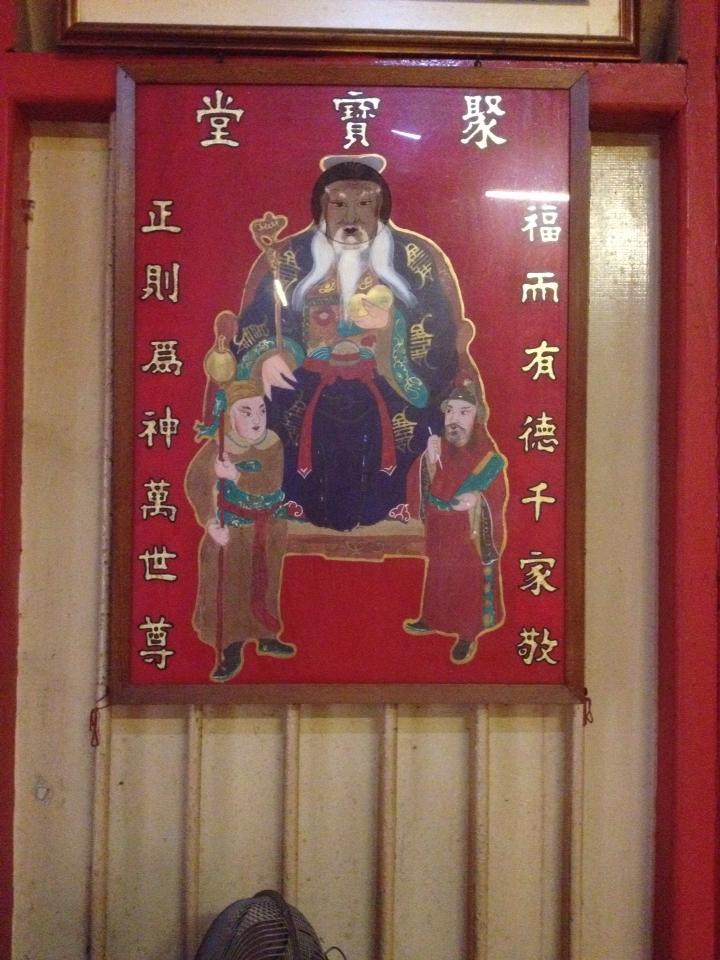
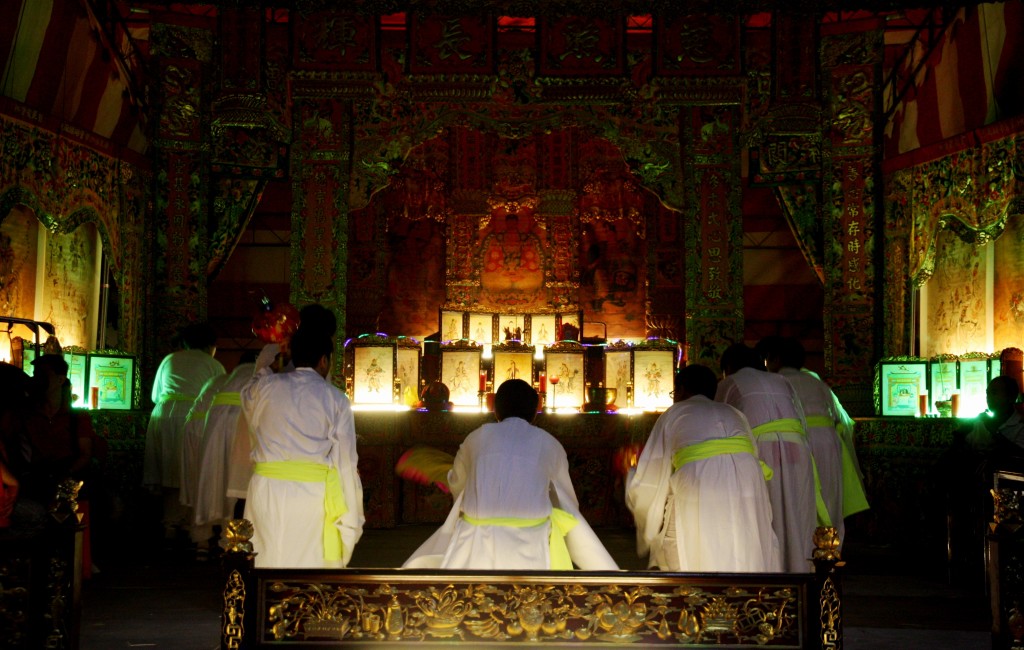
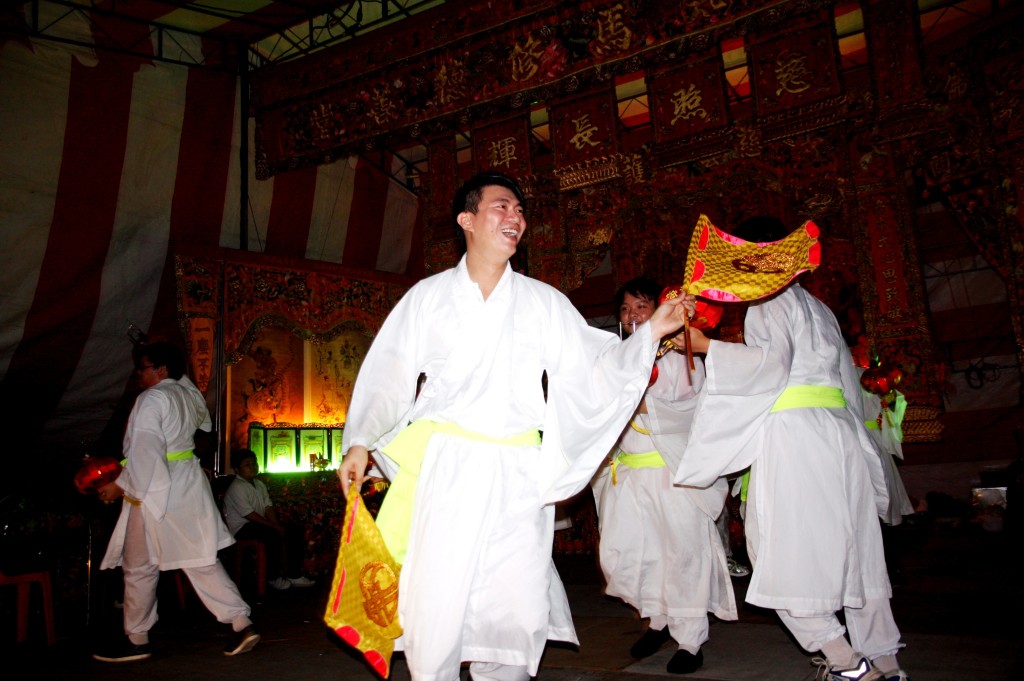
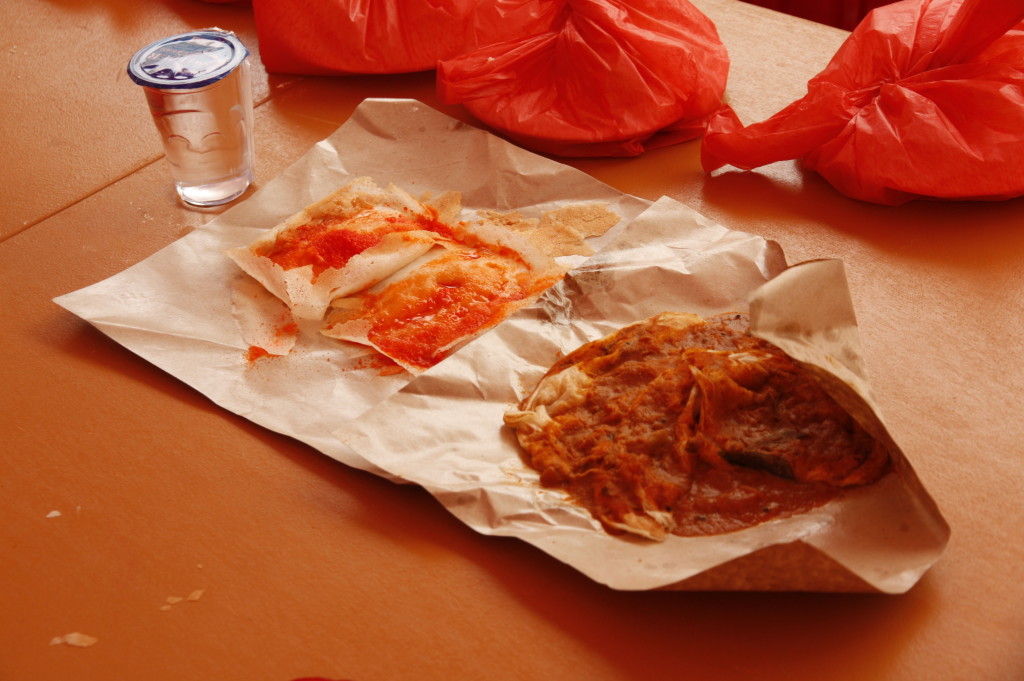
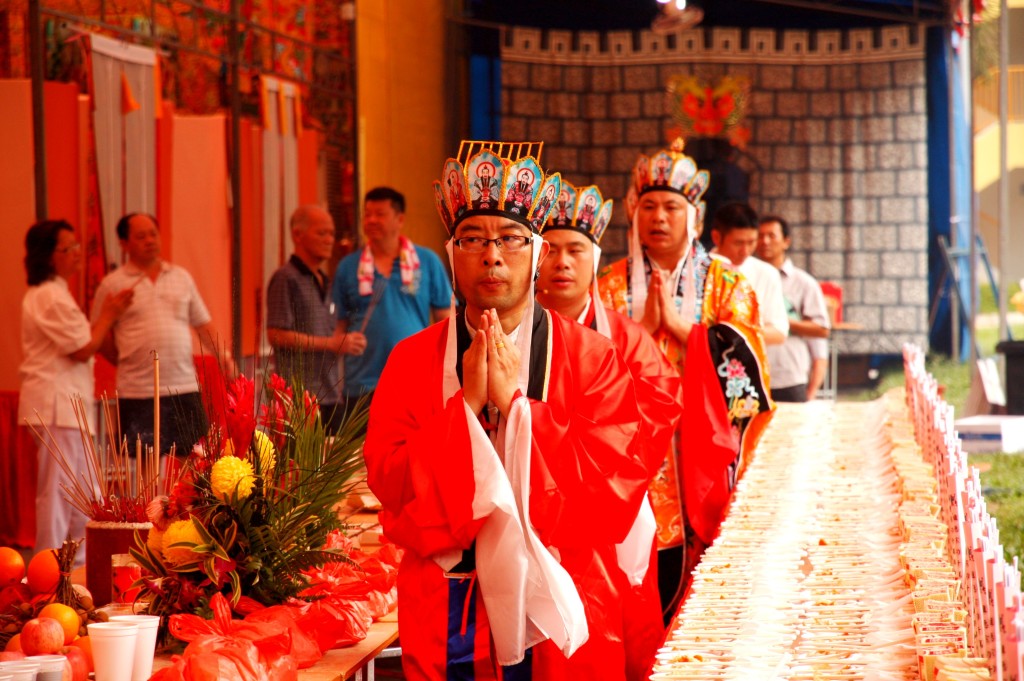
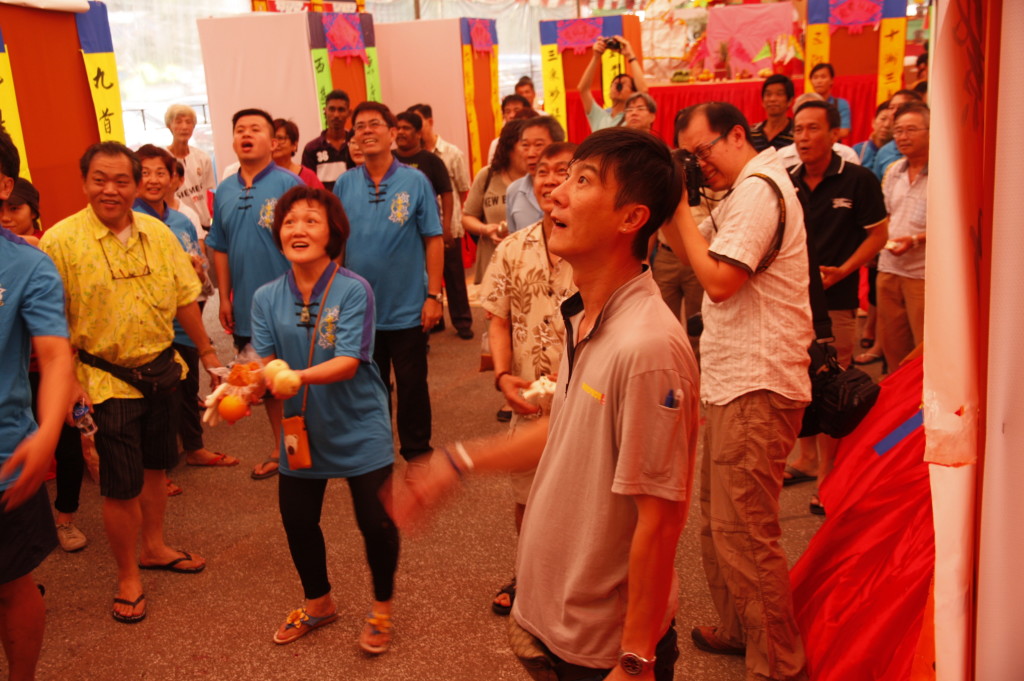



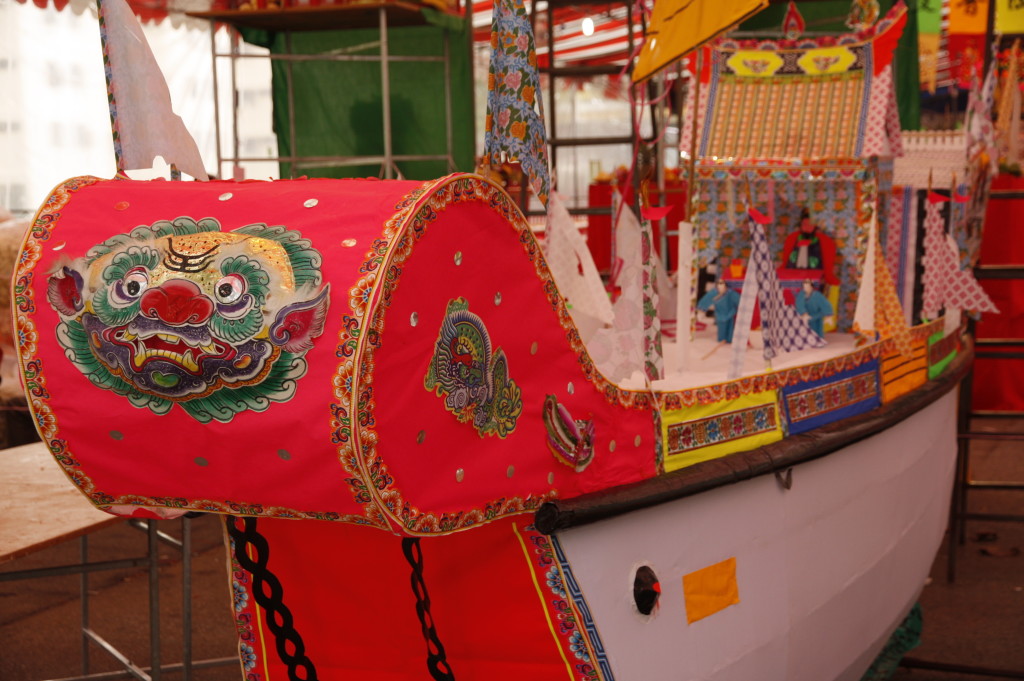
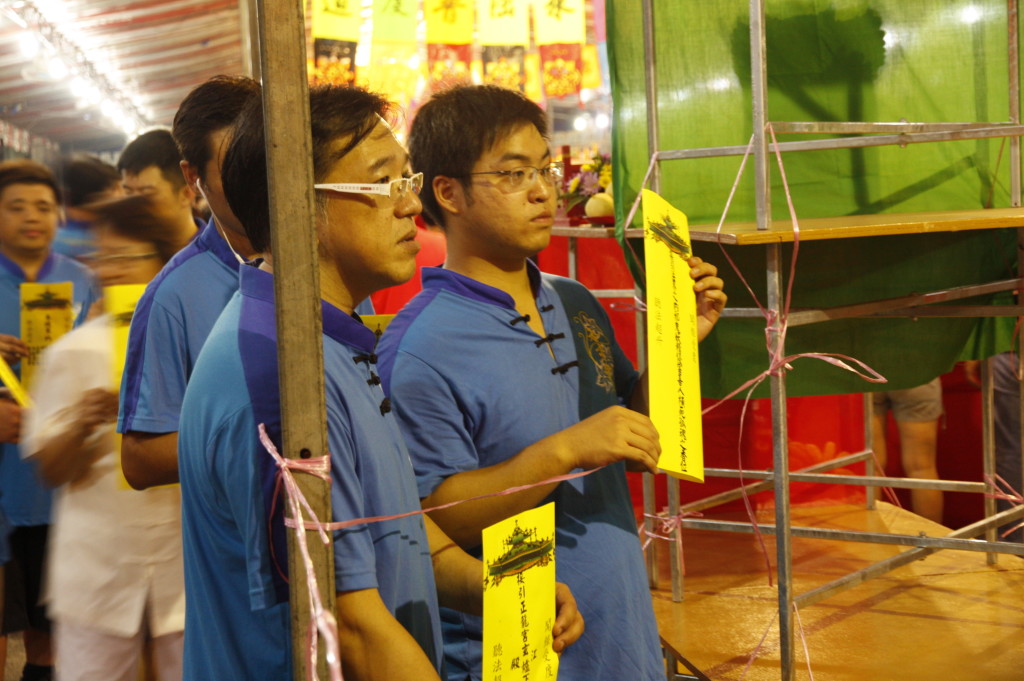
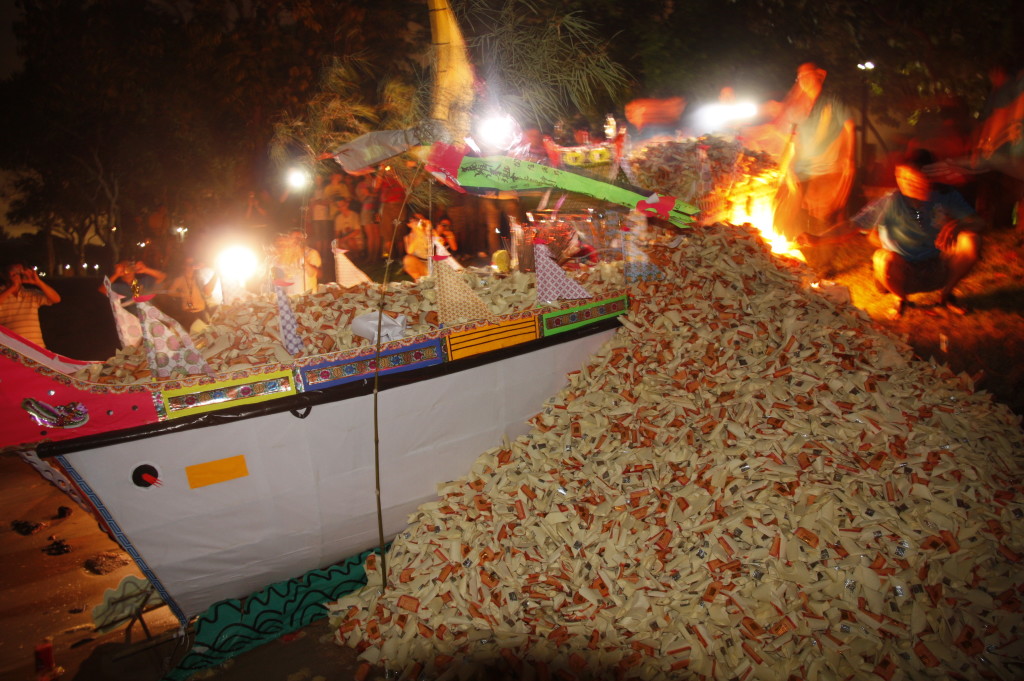
Recent Comments